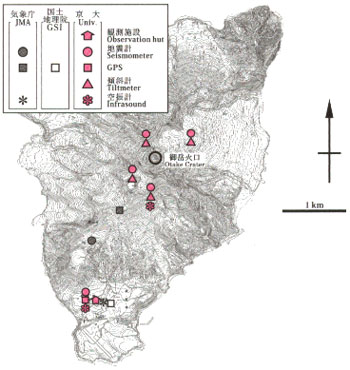Suwanosejima Volcano
1: Introduction / 2: The topography of Suwanosejima Volcano
3: Geological history
4: Products during the historical age / 5: Petrology
6: Recent activities
7: Geophysical observations / 8: Characteristics of the recent activity and hazards
References
![]() PREV
PREV ![]() NEXT
NEXT
7: Geophysical observations / 8: Characteristics of the recent activity and hazards
7: Geophysical observations
Geophysical observation of Suwanosejima Volcano is conducted mainly by the Japan Meteorological Agency (JMA) and the Disaster Prevention Research Institute (DPRI), Kyoto University as of 2012 (![]() Fig. 9). JMA established a continuous monitoring system using one seismometer on the southern flank of Otake and one infrasound monitor near the village area. The DPRI and some universities established another continuous monitoring system using 4 pairs of seismometers and tiltmeters around the active Otake crater and a set consisting of a seismometer, an infrasound microphone, and a GPS in the village area. The Geospatial Information Authority of Japan (GSI) also established a GEONET station in the village area. The JMA and the Japan Coast Guard (JCG) conduct visual aerial surveys of active craters periodically; the JMA also conducts on-site surveys occasionally.
Fig. 9). JMA established a continuous monitoring system using one seismometer on the southern flank of Otake and one infrasound monitor near the village area. The DPRI and some universities established another continuous monitoring system using 4 pairs of seismometers and tiltmeters around the active Otake crater and a set consisting of a seismometer, an infrasound microphone, and a GPS in the village area. The Geospatial Information Authority of Japan (GSI) also established a GEONET station in the village area. The JMA and the Japan Coast Guard (JCG) conduct visual aerial surveys of active craters periodically; the JMA also conducts on-site surveys occasionally.
Since February of 2005, the JMA has been classifying and announcing the degree of volcanic activity based on 6 levels, from 0 to 5, according to the results of the above-mentioned monitoring. The volcanic activity has been classified as level 2 (moderately active) since December of 2007 to date.
8: Characteristics of the recent activity and hazards
All the eruptions after the Bunka Eruption occurred at Otake crater. Eruptions occur successively due to the continuous ascent of andesitic magma from depths to the floor of the active vent. Small vulcanian, strombolian, and ash eruptions have been recorded. Some strong explosions carry volcanic bombs down to ca. 1-2 km from Otake crater. Volcanic ash and sand emitted as plumes are brought downwind in all directions, depending on the wind direction during emission.
Large-scale lava effusion has not occurred since the Meiji Eruption, during which lava reached the seashore. In cases when Otake crater effused lava similarly as in the Meiji Eruption, lava flows could go down through the valley toward the beach of Sakuchi.
Judging from the geological history, sub-Plinian eruptions, such as the Bunka Eruption, or more energetic eruptions may occur every some hundreds of years. Such eruption would cause coarse pyroclastic fragments to fall throughout the island. An eruption may occur at locations other than Otake crater. In similar cases to the 1813 eruption, pyroclastic flows may reach the village area.
It is obvious that Suwanosejima has collapsed several times in its history, and it is highly probable that Otake may collapse again, generating a debris avalanche and consequent tsunami in the sea. The collapse may be triggered by an eruption, such as in 1813, or by other activities, such as distal tectonic earthquakes.
